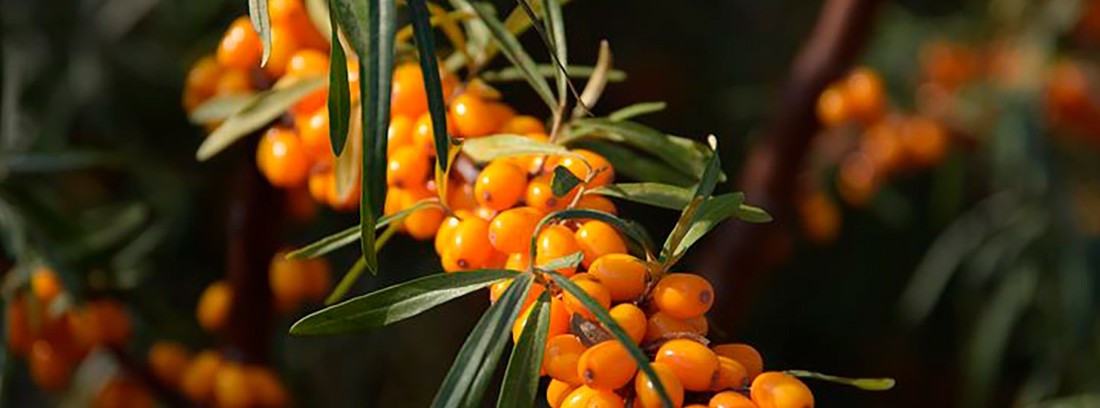Sea buckthorn and high defenses
 WHAT YOU NEED TO KNOW ...
WHAT YOU NEED TO KNOW ...
- The fruit of sea buckthorn are berries that have an orange-yellow color, are edible, juicy and have a somewhat acidic flavor.
- Its rich composition causes it to be used as a tonic to prevent colds, in convalescence and to improve states of asthenia (tiredness and weakness).
- In autumn, when the berries are ripe, they can be consumed in the form of juice, in the form of an infusion or preserved as a compote.
Plant
The bush of the sea buckthorn it reaches, as a general rule, one to three meters in height, although in some geographical locations it can triple this height. It is characterized by having a dense and thorny branch. The deciduous leaves (it loses its foliage in winter) are long, narrow and pale grayish green in color. It is a dioecious plant, with female feet and male feet, which in order to bear fruit it is necessary for the two types of shrubs to coexist. In the female plant the flowers, greenish in color and covered with rusty scales, appear in dense inflorescences, while in the male plant they appear in short spikes that appear before the leaves. The female plants are the ones that produce the fruits, the berries, orange-yellow in color, edible, juicy and with a somewhat acidic flavor.
The common name "sea buckthorn" refers to the numerous thorns on its branches and the yellow color of its fruits. As for its botanical name, Hippophae derives from the Greek words Ιππο (horse) and φαέ (eat), which seems to refer to the legend that says that sea buckthorn was the favorite food of the mythological Pegasus, from which it obtained strength and vigor. . As for the Latin term rhamnoides, its meaning is "similar to" and probably refers to its resemblance to other thorny shrubs that are also known under the common name of hawthorn (such as hawthorn). Hence it may come that, in Spanish, it is also called false hawthorn.
A little history
Sea buckthorn has been known and used in China since ancient times that seem to date back to the Tang dynasty (7th-8th centuries). Its use is reflected in the texts of traditional Tibetan medicine from the 8th century, which describe the ability of the fruits of this plant to tone the “yin” and strengthen the “yang”. In India it is part of the arsenal of traditional Ayurvedic medicine. In ancient Greece, Dioscorides described its invigorating properties and it seems that Genghis Khan's army drank the juice of the fruits to increase resistance and soldiers used it as a wound healer.
Already in the 20th century, its medicinal properties were highly studied in Russia and Russian cosmonauts took containers of sea buckthorn juice into space to increase its strength and resistance. Apparently, it was the first juice that was taken into space. At the Olympic Games in Seoul, the juice of sea buckthorn fruits was classified as an official drink.
Current uses
Sea buckthorn is high in (approximately 2,750mg / 100g), vitamin E (300mg / 100g), B vitamins, vitamin K, essential fatty acids (omega-7, omega-6 and omega-3) , flavonoids, flavonols and carotenoids. It is due to this rich composition that the sea buckthorn fruit, its juice and the preparations based on its extracts, have antioxidant activity that, together with its contribution vitamin and nutritional, They make it traditionally used as a tonic to prevent colds, convalescence and to improve the states of (tiredness and weakness).
An oil is also extracted from the fruits of the sea buckthorn which, due to its aforementioned richness in vitamin C, omega-7 fatty acids and other fatty acids, is used in cosmetics for its nourishing and regenerating properties of the skin.
How to take it?
- Fluid extract: 15-30 drops, one to three times a day.
- Tincture: 30-50 drops, one to three times a day.
- Syrup: two or three tablespoons a day.
In autumn, when the fruit is ripe, it can be consumed in the form of juice (one tablespoon three times a day), in the form of an infusion or preserved as a compote.
To make an infusion ...
40 to 50 g of fresh fruits are used per liter of water. Boiling water is poured over the fruits and allowed to infuse for 30 minutes. Strain and take two or three cups a day. At room temperature and sweetened with a little honey, it is a pleasant and refreshing drink. It can also be taken hot but without boiling.
To make a compote ...
Mix the pulp of the fruit with sugar in equal parts by weight, and stir until a homogeneous puree is formed. To preserve, pack in special glass jars for preserving, cooking in a water bath for 20 minutes. You can take a teaspoon several times a day.
Contraindications, adverse effects and recommendations
No contraindications, adverse effects or other precautions have been described.
(Updated at Apr 13 / 2024)